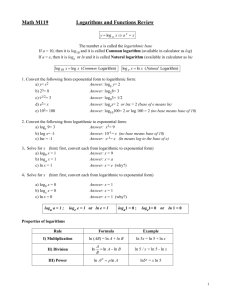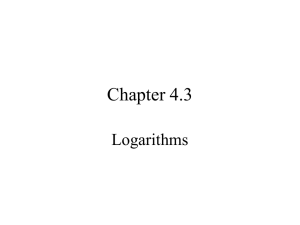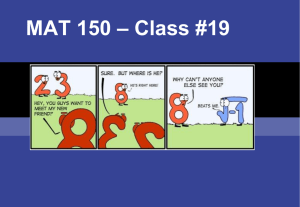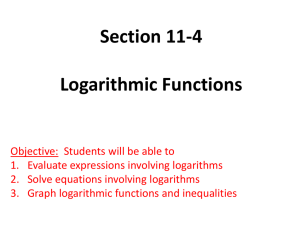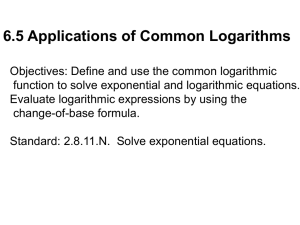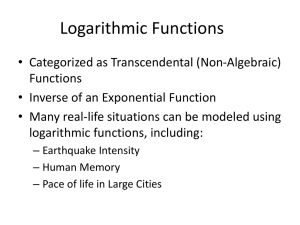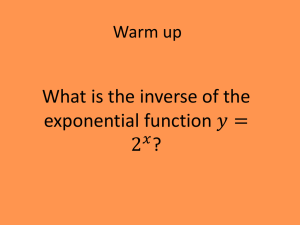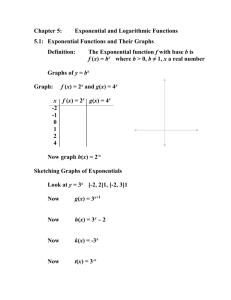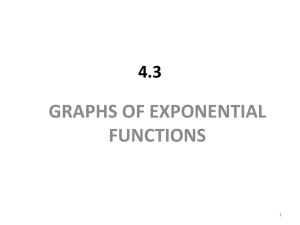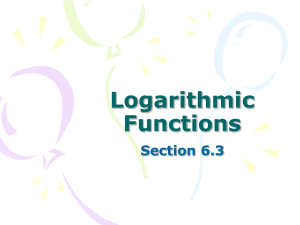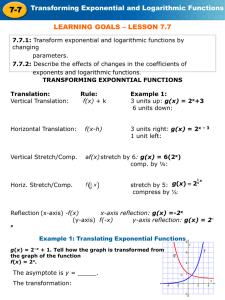Session 12
advertisement
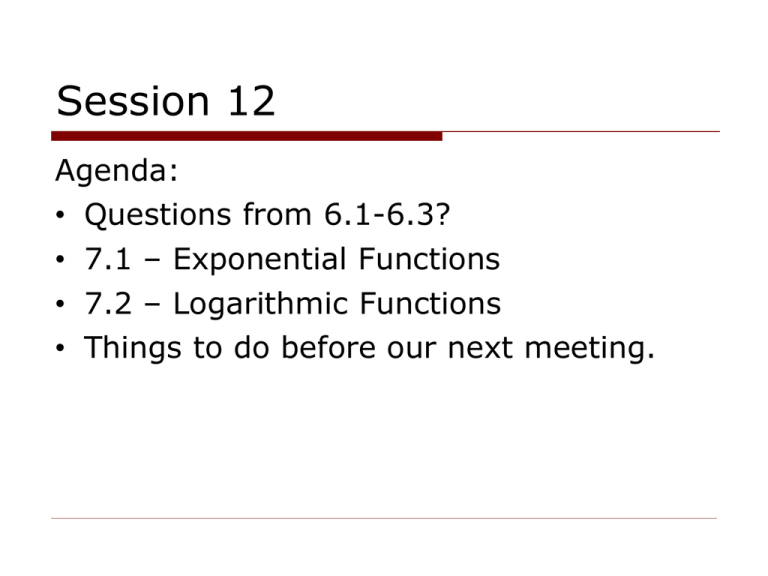
Session 12 Agenda: • Questions from 6.1-6.3? • 7.1 – Exponential Functions • 7.2 – Logarithmic Functions • Things to do before our next meeting. Questions? 7.1 – Exponential Functions • An exponential function is a function of the form f ( x) a x , a 0, a 1 • The number a is called the base of the exponential function. x • Given the exponential function f ( x) 3 , evaluate the following: f (0) f (1) f (2) f (1) f (2) Using the values you just found, sketch a graph of the function. f (0) 1 f (1) 3 1 3 1 f (2) 9 f (1) f (2) 9 • Domain:__________ • Range:___________ • What happens as x∞? f(x) ______ • What happens as x-∞? f(x)______ • Are there any asymptotes? x • In general, every basic exponential function f ( x) a where a>1 has the same properties and general shape. • y-intercept of (0,1) • No x-intercept • Horizontal asymptote: y=0 • No vertical asymptote • Domain: (-∞,∞) • Range: (0,∞) • Always increasing. • As x∞, f(x) ∞ • As x-∞, f(x) 0 • The most commonly used exponential function is the natural exponential function, which has base e. f ( x) ex • All the properties from before still hold for this function. • The number e is an irrational number whose value is between 2 and 3. The graph of e x is shown in red between the graphs of 2 x and 3x. x • 1 Consider the function f ( x) . Evaluate the following and sketch a 2 graph. f (0) f (1) f (1) f (2) f (2) • Domain:__________ • Range:___________ • What happens as x∞? f(x) ______ • What happens as x-∞? f(x)______ • Are there any asymptotes? • In general, every basic exponential function f ( x) a where 0<a<1 has the same properties and general shape. x • y-intercept of (0,1) • No x-intercept • Horizontal asymptote: y=0 • No vertical asymptote • Domain: (-∞,∞) • Range: (0,∞) • Always decreasing. • As x∞, f(x) 0 • As x-∞, f(x) ∞. • Consider the function f ( x) 2 x . Sketch a graph using a x transformation of the parent function 2 . • This is the same graph as x x 1 1 1 f ( x) since 2 x x . 2 2 2 • This is a decreasing exponential function. x • The graph of f ( x) e is also a reflection of e x across the y-axis and is a decreasing exponential function. Its graph x x is shown below in red between the graphs of 2 and 3 . x • 1 Consider the function f ( x) . What is this graph 3 equivalent to? • Is this an increasing or decreasing exponential function? • In general, a function of the form f ( x) a x , • Is decreasing if a>1. • Is increasing if 0<a<1. a 0, a 1 Sketch graphs of the following exponential functions using transformations. Identify any asymptotes and whether the function is increasing or decreasing. x f ( x) 2e 4 1 g ( x) 1 3 x 2 • Due to the fact that exponential functions are one-to-one, the following is true: If a x a y , then x y • This fact can be used to solve exponential equations where both sides can be expressed with a common base. • Solve the following equations. 25 x 16 1 92 x 27 x 1 1 25(53 x ) 5 x 7.2 – Logarithmic Functions • Since exponential functions are one-to-one, they have x inverse functions. The inverse function of f ( x) a (a 0, a 1) is the logarithmic function with base a. f ( x) loga ( x), defined by a 0, a 1 y loga ( x) a y x • A logarithm is the EXPONENT to which the base must be raised to get x. • Evaluate the following: log 2 16 1 log3 81 log100 1 log9 3 log5 0 log 7 (49) • Important: You can ONLY take the logarithm of positive numbers. • Solve for x: 5x log4 64 9 log6 x 4 7 • Given f ( x) log3 x, evaluate the following and sketch a graph. 1 1 log3 log3 9 3 log3 (1) log3 (3) • log3 (9) Domain:__________ • Range:___________ • What happens as x∞? f(x) ______ • What happens as x0+? f(x)______ • Are there any asymptotes? • In general, every basic logarithmic function f ( x) loga x where a>1 has the same properties and general shape. • x-intercept of (1,0) • No y-intercept • No Horizontal asymptote • Vertical asymptote x=0 • Domain: (0,∞) • Range: (-∞,∞) • Always increasing. • As x∞, f(x) ∞ • As x0+, f(x) -∞ • The logarithmic function with base 10 is called the common logarithmic function and is usually just written as f ( x) log( x) . • A special logarithmic function is the natural logarithmic function which has base e. Instead of writing f ( x) loge ( x) , we write this function as f ( x) ln( x) . • The graphs of both these functions have the same general shape as any logarithmic function with base >1. • Cancellation Properties: log a (a x ) x a loga x x ln(e x ) x eln( x ) x Evaluate the following, if possible. ln(e) log 4 (41000 ) ln(1) log(1) 1 ln 2 e 1 log 100 5log5 12 log 64 (e ln 4 ) Sketch graphs of the following functions using transformations. Identify any asymptotes and the domain of the function. f ( x) ln( x 2) f ( x) log2 ( x) 3 Find the domains of the following functions. f ( x) log(5x 9) g ( x) ln(8 2 x) ln( x 9) h( x ) 3 log 2 x 2 Find the domain and range of the following function. f ( x) ln 4 x 1 Properties of Logarithms log a ( xy ) log a x log a y x log a log a x log a y y log a ( x c ) c log a x • Expand the following completely. Evaluate any known logarithms. 9 x2 log 3 y e( x y ) 2 ln 2 7 x y • Write the following as a single logarithm. 1 log( y ) 3log(2 x) log( x y ) 3 • Given that logb 2 n, logb 3 k , logb 7 w, write logb 504 in terms of n, k, and w. Change of Base Formula • Any logarithm can be converted to a logarithm with another base using the following formula. log a x logb x log a b • Write log12 x using natural logarithms. • If log4 x 2.8 , find log2 x . Things to Do Before Next Meeting: • Work on Sections 7.1-7.2 until you get all green bars! • Write down any questions you have. • Continue working on mastering 6.1-6.3. After you have all green bars on 6.1-6.3, retake the Chapter 6 Test until you obtain at least 80%.

